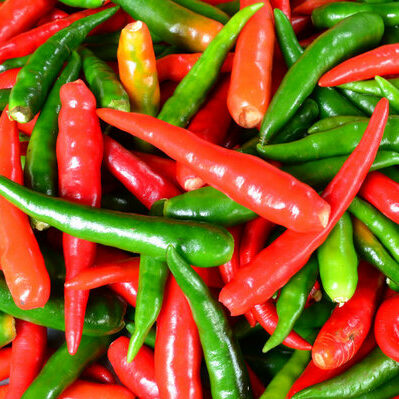
Chili Pepper
also known Chile or Chilli
What is Chili Pepper?
Chili pepper is the fruit of several plants in the Capsicum genus. The origin of the word comes from the Mexican Nahua people’s language, Nahuatl, in which the fruit has the same name. These hot and pungent fruits are members of the nightshade family. Most varieties of chilies are elongated but a few may be round in shape.
- They may be found in green, red, or yellow colors, and the deeper the color, the more pungent is the taste.
- The heat level of the chilies is measured by the Scoville unit.
Some of the hottest chili peppers in the world are:
- Carolina Reaper
- Trinidad Moruga Scorpion
- 7 Pot Douglah
- 7 Pot Primo
- Trinidad Scorpion “Butch T”
- Naga Viper
- Bhut Jolokia
- 7 Pot Barrackpore
- 7 Pot Red
- Red Savina Habanero
- Dragon’s Breath
- Pepper X
Origin of chili pepper
These peppers originated in South America and have been used extensively by Mesoamericans. The earliest archaeological findings of chilies were 6,000 years ago in Ecuador. Christopher Columbus, in addition to mistakenly calling the Caribbean Islands “Indies” and the local population as “Indians”, also misnamed the chili plant as “pimiento”, similar to the Spanish name for black pepper, pimienta. The Portuguese spread it around the world through trade and colonization. Not to mention, chili peppers were later used in an important discovery about how humans feel pain.
Nutrition
Nutritional profile for chili pepper (1 piece, green, raw):

Chili peppers are rich in calcium, magnesium, phosphorus, potassium, vitamin C, folate, choline, vitamin A, carotene, cryptoxanthin, lutein + zeaxanthin, and vitamin K. Also, chili peppers have multiple health benefits. Regular consumption may help in decreasing cholesterol and hypertension, increasing absorption of healthy fats (HDL) and satiety, as well as preventing diseases like diabetes, obesity, gastrointestinal diseases, and cardiovascular diseases. In addition, they have antibacterial and anticancer properties, and may help in managing atherosclerosis and metabolic syndrome.
Commercial production
The main chili pepper producing countries are China, Mexico, Turkey, Indonesia, India, and Spain. Chilies require a warm climate and thrive in a mix of humid and dry weather. They grow well in dark soil that retains moisture or in sandy loam soil with good drainage. The harvesting is done according to the intended use of the fruits.
Chilies can remain fresh in the refrigerator for up to one month. Rotting is slightly delayed if they are stored with the stalks removed.
Chili pepper recipes
These peppers are used to enhance flavor and increase the spice level of a dish. They are extensively used in South American, Asian, and African cuisines. Here are a few recipes to try:
- Chili Soup
- Tomatillo Sauce
- Chakalaka
- Kambuzi Chilli Chutney
- Harissa
- Jollof Rice
- Mirchi ka Salan
- Mirapakaya Bajji
- Mogo
- Thai Noodles
- Green Curry
- Chilli Chicken
- Ayamase
- Stuffed Green Chillies
- Ayam Berlado Hijau
- Chile Verde
- Pepperoncino
- Penne all’Arrabbiata
FDA regulations
The FDA classifies chilies under the category of generally recognized as safe. Also, they describe it as a spice.
References
Jodi Ettenberg, A Brief History of Chili Peppers, Legal Nomads, https://www.legalnomads.com/history-chili-peppers/
Sanati, Setareh et al. “A review of the effects of Capsicum annuum L. and its constituent, capsaicin, in metabolic syndrome.” Iranian journal of basic medical sciences vol. 21,5 (2018): 439-448. doi:10.22038/IJBMS.2018.25200.6238, https://www.ncbi.nlm.nih.gov/pmc/articles/PMC6000222/
